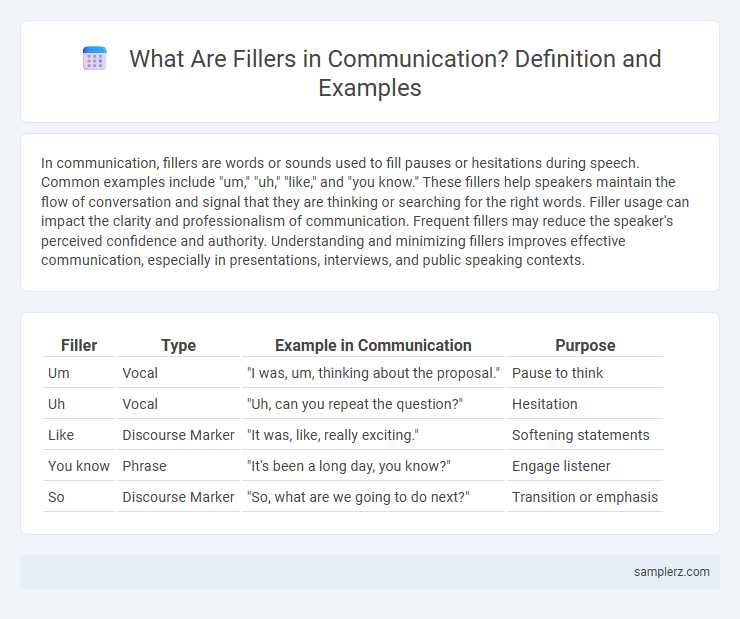In communication, fillers are words or sounds used to fill pauses or hesitations during speech. Common examples include "um," "uh," "like," and "you know." These fillers help speakers maintain the flow of conversation and signal that they are thinking or searching for the right words. Filler usage can impact the clarity and professionalism of communication. Frequent fillers may reduce the speaker's perceived confidence and authority. Understanding and minimizing fillers improves effective communication, especially in presentations, interviews, and public speaking contexts.
Table of Comparison
| Filler | Type | Example in Communication | Purpose |
|---|---|---|---|
| Um | Vocal | "I was, um, thinking about the proposal." | Pause to think |
| Uh | Vocal | "Uh, can you repeat the question?" | Hesitation |
| Like | Discourse Marker | "It was, like, really exciting." | Softening statements |
| You know | Phrase | "It's been a long day, you know?" | Engage listener |
| So | Discourse Marker | "So, what are we going to do next?" | Transition or emphasis |
Understanding Fillers in Communication
Fillers in communication, such as "um," "uh," and "like," serve as pauses that allow speakers to organize thoughts or signal hesitation without disrupting the flow of conversation. These verbal placeholders often help maintain listener engagement by providing time to process ideas and prepare responses. Recognizing fillers can enhance effective communication by distinguishing between deliberate speech choices and unintended uncertainty.
Common Verbal Fillers: Examples and Usage
Common verbal fillers in communication include words like "um," "uh," "like," and "you know," which speakers use to pause or hesitate while thinking. These fillers often occur in spontaneous speech and can signal uncertainty or a need for more time to formulate thoughts. Understanding the usage of such fillers helps improve clarity and effectiveness in both casual and formal conversations.
Nonverbal Fillers: What Do They Look Like?
Nonverbal fillers in communication often include gestures such as tapping fingers, shifting body weight, or avoiding eye contact, which signal hesitation or uncertainty. These subtle behaviors serve as pauses that give the speaker time to think without interrupting the flow of conversation. Recognizing nonverbal fillers helps improve interpretive skills and fosters clearer, more confident communication.
Fillers in Everyday Conversations: Sample Phrases
Common fillers in everyday conversations include phrases such as "um," "like," "you know," and "I mean," which speakers use to signal hesitation or to hold their turn in dialogue. These filler words help maintain the flow of speech while allowing time to think or organize thoughts. Frequent use of such fillers can impact perceived communication clarity and professionalism.
The Role of Fillers in Smoothing Dialogue
Fillers such as "um," "like," and "you know" play a crucial role in smoothing dialogue by signaling hesitation and giving speakers extra time to formulate thoughts without losing the listener's attention. These verbal pauses help maintain conversational flow and indicate that the speaker is still engaged, reducing the chances of interruptions. Effective use of fillers enhances natural communication and aids in managing the pacing of speech.
Fillers Across Different Languages and Cultures
Fillers such as "um" and "uh" in English, "este" in Spanish, and "eto" in Japanese serve as universal tools for speakers to pause and gather their thoughts without yielding their turn in conversation. These linguistic pauses vary significantly across cultures, reflecting unique communication norms and comfort levels with silence or hesitation. Understanding fillers in diverse languages enhances cross-cultural communication by highlighting how speakers manage conversational flow and signal uncertainty or contemplation.
Professional Contexts: Fillers in Business Communication
In professional contexts, common fillers such as "uh," "you know," and "like" frequently appear during business presentations and meetings, potentially undermining speaker credibility. Research highlights that excessive use of fillers can distract listeners and reduce message clarity, affecting overall communication effectiveness in corporate environments. Replacing fillers with brief pauses or deliberate phrasing enhances professionalism and reinforces audience engagement.
Fillers in Public Speaking: Examples and Impact
Fillers in public speaking, such as "um," "uh," and "like," frequently interrupt speech flow and can diminish speaker credibility. These verbal pauses often signal hesitation, reducing audience engagement and the perceived professionalism of the presentation. Effective public speakers practice minimizing fillers to enhance clarity, maintain listener attention, and strengthen message delivery.
Reducing Overuse: Strategies for Managing Fillers
Strategies for managing fillers like "um," "uh," and "like" in communication include practicing mindfulness to increase awareness of speech patterns and using deliberate pauses to replace unnecessary sounds. Recording and reviewing conversations help identify filler overuse, enabling speakers to consciously reduce reliance on these pauses. Employing techniques such as slow speaking pace and structured thoughts can significantly enhance speech clarity and audience engagement.
When Fillers Enhance vs. Hinder Communication
Fillers such as "um," "uh," and "like" can enhance communication by providing speakers with brief pauses to organize thoughts, maintaining a natural flow and preventing awkward silences. However, excessive or inappropriate use of fillers may hinder communication by distracting listeners, reducing clarity, and undermining the speaker's credibility. Effective communicators balance filler usage to support fluency without compromising message impact.

example of filler in communication Infographic
 samplerz.com
samplerz.com